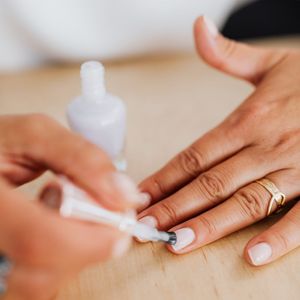I only learned about Russian Manicures recently — and I must say, I was quite intrigued. In a TikTok posted by @juliagmonty, Jules leads viewers through her monthly Russian Manicure in NYC. The short video instantly sent me into a rabbit hole to investigate: Exactly what areRussian Manicures? Why are they gaining popularity? What makes them so special? As it turns out, this technique is just as controversial as it is beloved.
Before you check out all of our fall nail design inspo, here's everything you need to know about the technique.
What are Russian Manicures?
The name "Russian Manicure" is essentially synonymous with the more commonly-known name of “Eastern-European manicure.” The technique is derived from the ultra-clean, polished nature of manicures done by these specially trained nail technicians, with a specific focus on cuticle care.
In a video posted to @NailmArtUsa's TikTok, the technician demonstrates the technique, starting with cleaning and trimming the cuticles. "The cuticle work is very precise and the tools used go through a three-phase disinfection and sterilization process," she explains.
Following the preparation of the cuticles, your nails are topped with a limited edition base coat strictly used for Russian Manicures. This coat is entirely dependent on the strength of your nails, and is then followed by your gel polish of choice and a topcoat.
Russian Manicures differ from traditional gel manicures through their bespoke technique, one that specifically caters to the individual client's needs. Most notably, the cuticles are precisely trimmed so that they grow out with the nail bed, allowing for a more seamless regrowth (and a longer time before your next salon visit).Are Russian Manicures Safe?
This is where the controversy comes in, and why so many people haven't heard of this technique. Drilling off the cuticle is prohibited in some states due to safety concerns, and even the American Academy of Dermatology recommends avoiding cuticle removal.
"Cuticles protect the nail root, so it's important to avoid cutting your cuticles or pushing them back," the AAD shares. "When you trim or cut your cuticles, it's easier for bacteria and other germs to get inside your body and cause an infection."
Even so, before these technicians are permitted to specialize in Russian Manicures they must be highly educated and trained in the technique. In top salons, owners strictly hire graduates of nail schools specializing in Russian Manicures with at least two to three years of field experience who have successfully passed an in-house test. As always, though, it's best to do your research when looking for a qualified professional to perform any beauty service — including Russian manicures.
Why Should I Get A Russian Manicure?
The process utilizes nontoxic gel polishes and relies on restoring and protecting the health of your nails. In fact, and even the most brittle of nails can be restored within a few sessions. Additionally, the quality of the manicure lasts well over a month, with the average client revisiting their salon around 5 weeks following their last manicure.
As always, before trying anything new be sure to do your research. Make sure the procedure is right for you, the studio is clean, and the technician is highly trained.
Will you give Russian Manicures a try? Let us know @BritandCo!
Header image courtesy of Karolina Grabowska/Pexels.
